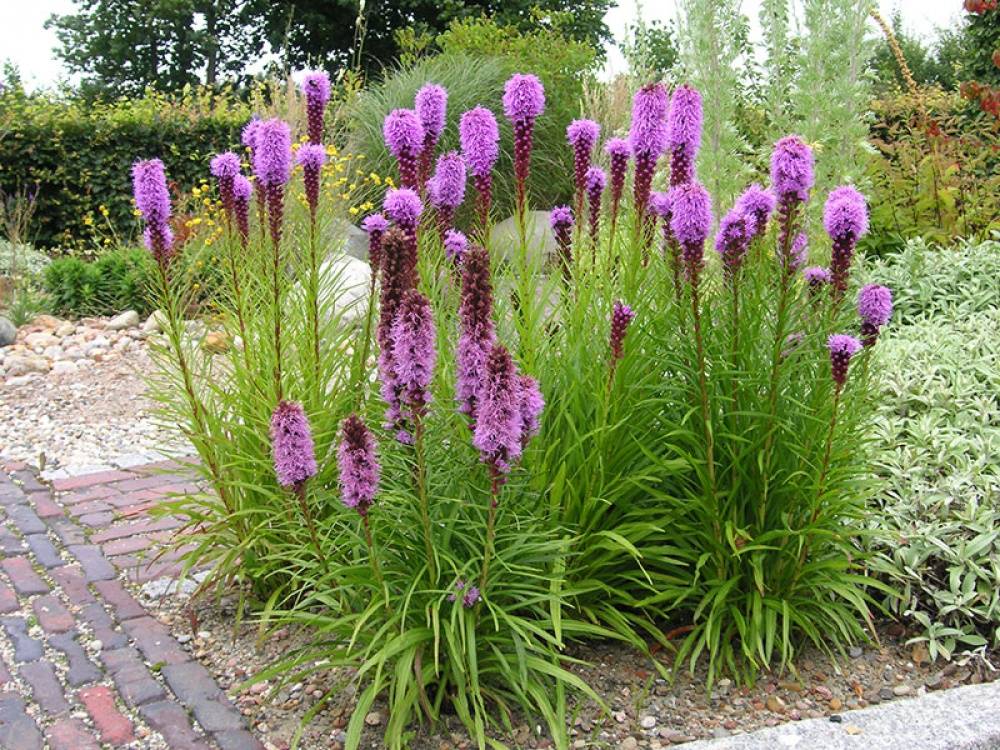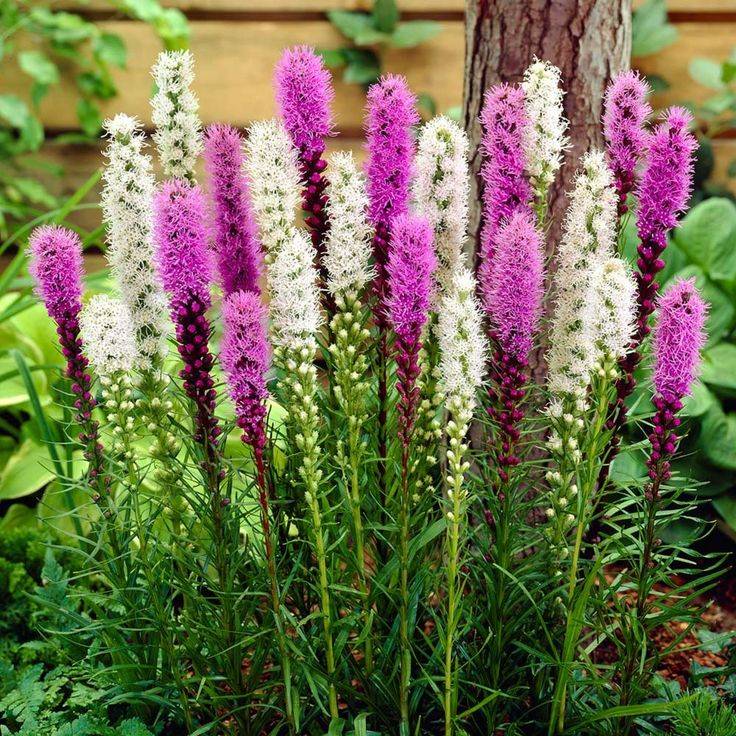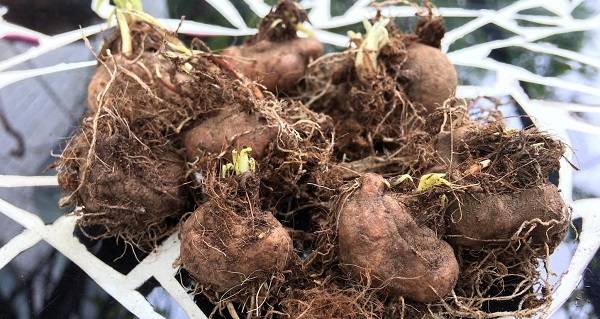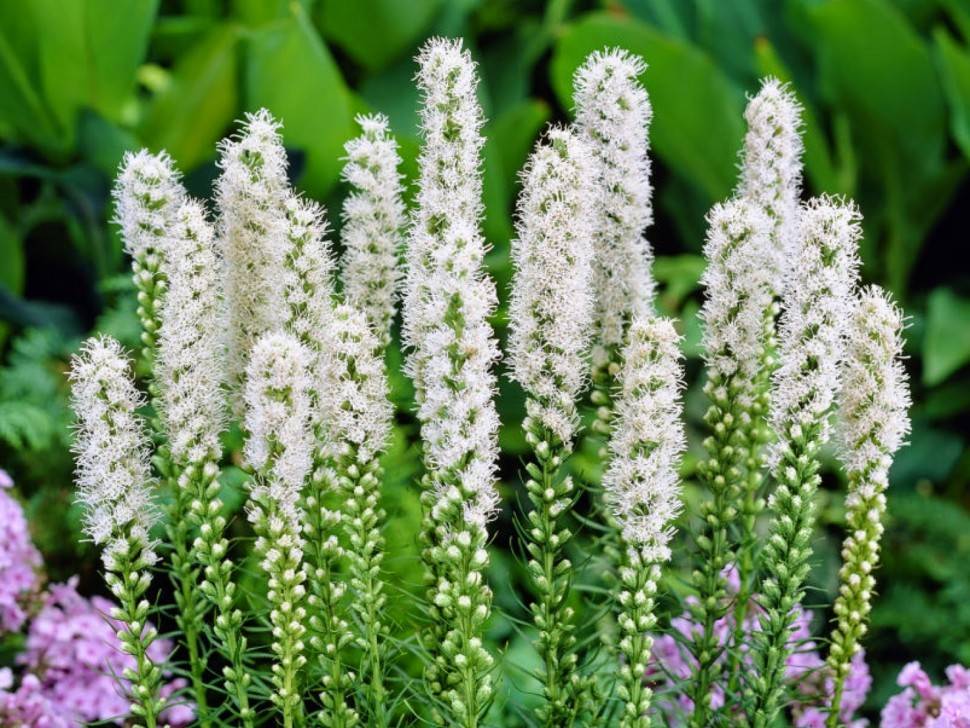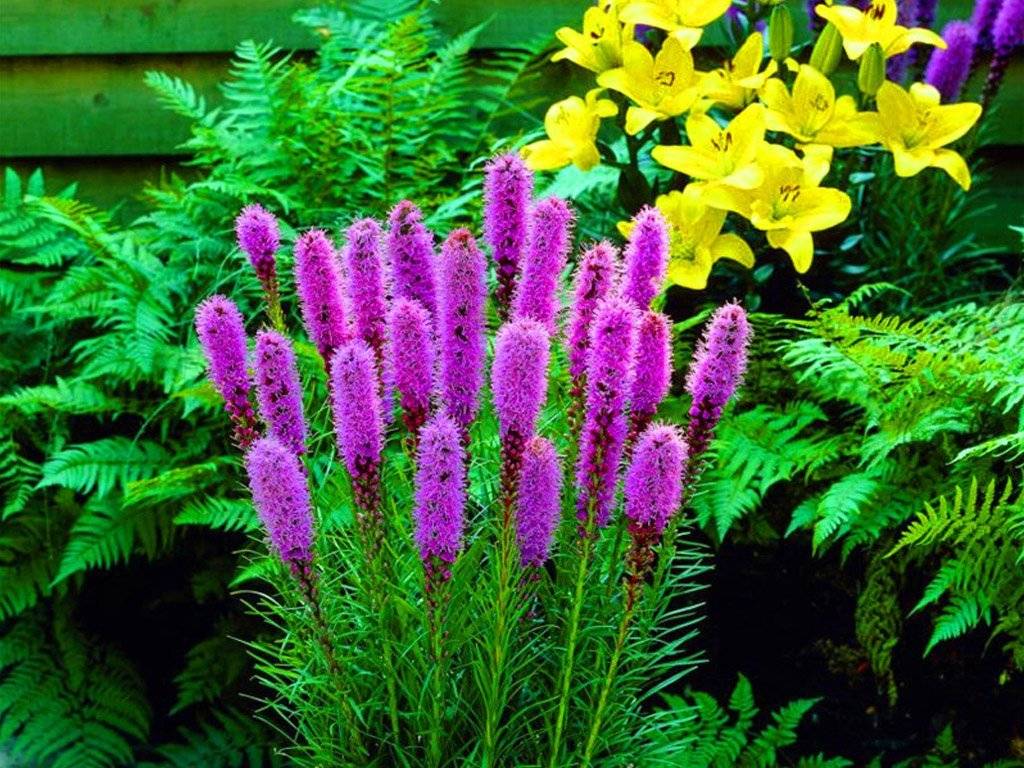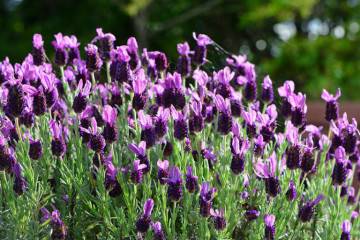Liatris - planting and care in the open field
Content:
The perennial liatris enjoys a well-deserved popularity among florists, planting and caring for which in the open field will not be difficult even for a beginner. The flower is distinguished by its unpretentiousness, endurance, has a long flowering and an original shape of inflorescences. In combination with other plants, liatris looks spectacular in small compositions, serves as an element of landscape design when decorating parks and squares.
Description of Liatris: varieties and varieties
Liatris is a perennial flowering plant of the Asteraceae (Asteraceae) family. In the wild, it is found in North America, where it grows everywhere. In areas with a warm climate, the height of the bush reaches 1.5-2 m. In the gardens of Europe, liatris flower has been known since the 18th century.
Of the 50 known botanical species, only three are cultivated:
- spikelet (Liatris spicata) is the most common species in cultivated floriculture, which is distinguished by its unpretentiousness. Its height is 40-80 cm, depending on the variety;
- membranous (Liatris scariosa) with wider (up to 3 cm) shiny leaves;
- rough (Liatris aspera) - the tallest species, plant height reaches one and a half meters. Pink panicles are inconspicuous, the species is rarely found in flower beds.
According to the description, the perennial is rosettes with narrow whorled dark green lanceolate leaves, pointed at the end. Before flowering, it throws out leafy peduncles in the lower part 40-60 cm long. The tubular flowers of liatris form miniature inflorescences-baskets, collected in common spike-shaped inflorescences.
The color of the petals is varied:
- white;
- pink;
- cherry;
- purple;
- blue;
- purple.
The root system of Liatris is a corm, connected by roots in nests of several pieces. The fruit is an oblong achene covered with villi.
Through the efforts of breeders, the following varieties have been bred:
- Cobalt (Kobold) is a compact undersized bush 30-50 cm high. Violet flower stalks reach 30 cm. Liatris bloom is possible from June to October;
- Blu Berd is a short plant with spike-shaped inflorescences of the original blue-lilac color. Blooms from mid-June to mid-August;
- Alba (Alba) - a plant 60-100 cm high, inflorescences are covered with small snow-white flowers with lace petals;
- Flamingo is a chic variety with fluffy pink stalks. Blooms a little later, in the second half of summer, drought-resistant;
- Floristan Violett (Floristan Violett) is a tall plant 0.8-1.2 m with purple-lilac flowers. The variety is picky about lighting;
- Sparklers are a miniature bush with deep purple spikelets. At a height of no more than 30-40 cm, it produces a large number of peduncles, has a long flowering period;
- The burning star throws out colorful cherry-colored flower stalks 60-70 cm in size. It blooms in July-August. The variety is unpretentious, frost-resistant, often self-sowing;
- Picador is a plant with fluffy red-purple inflorescences, similar to peaks, 60 cm high.The variety is light-requiring, prefers moderate watering.
Planting site and soil
Liatris prefers open spaces with good lighting. He does not like to grow in lowlands with stagnant water, in shaded areas, in places with a close occurrence of groundwater. Perennial grows well on fertile air and water impermeable slightly acidic soils with a pH of 6.0-6.5.
The plant can grow and bloom on poor sandy and sandy loam soils, but the bush will be smaller, and the peduncles and flowers are smaller. Heavy clay soils are not very suitable for the cultivation of perennials.
For planting in pots and containers, the soil is prepared in the following proportions:
- peat - 60%;
- sand or perlite - 10%;
- sod land - 30%.
Sowing Liatris seeds in open ground
Perennial seeds ripen during the growing season on peduncles. Even in temperate climates, they can be harvested and used for planting. The germination rate of planting material does not exceed 50%. For Liatris seeds to sprout, they need stratification - staying in a cool place. When sown in November, this process will occur naturally during wintering. When sowing in spring, the seeds need to be kept in the refrigerator for about a month.
With seed propagation, the obtained seedlings do not fully retain the properties of the mother plant, especially if several varieties grow on the site.
Before sowing, calibration is carried out in salt water, discarding hollow, immature seeds. The planting material is soaked in a solution of potassium humate (0.5 g per 1 l of water) for 12 hours. Pre-planting preparation improves germination, accelerates seed germination.
The planting site is cleared of weeds, dug up with humus or compost - 1 bucket per 1 m². Grooves are made at a distance of 10 cm, the seeds are planted to a depth of 1 cm. In spring planting, they sprout in two weeks. When real leaves appear, the seedlings are thinned out.
Planting Liatris in open ground
A perennial can be grown in seedlings by planting seedlings in the soil at the age of 50-60 days. Seeds that have undergone stratification and pre-planting are sown in a container with pre-disinfected soil. The composition of the substrate should be lightweight, breathable. Sowing is carried out in January-March, the planting material is deepened by 1 cm. The container with the crops is covered with film or glass, placed in a warm place with a temperature of 22-25 ° C.
When 1-2 true leaves appear, the seedlings dive into separate small pots, after a month they are transshipped in a larger container. Seedlings are transplanted into open ground when the threat of night frosts has passed. The distance between plants is maintained at 20-25 cm.
Watering and loosening the soil
Spikelet liatris is a drought-resistant plant that tolerates a lack of moisture better than an excess of it. For most of the growing season, rainwater is sufficient for the plant. In hot dry weather, the flower is rarely watered, but abundantly, so that the quality of flowering does not deteriorate.
In the process of growth, the root system of the liatris is exposed, the corms appear on the surface of the soil. With the help of loosening, which must be carried out very carefully so as not to damage the roots, the tubers are buried in the ground. The flower responds well to root mulching with peat, grass cuttings, fallen leaves. This measure protects the root system, serves as a fertilizer, and prevents disease.
Reproduction methods
Liatris is extremely unpretentious when planting and leaving. Plant propagation is possible in several ways:
- seeds;
- corms;
- dividing the bush.
The plant grows well in one place for no more than three years. Older bushes need to be divided. Old neglected plantings begin to throw out a small number of peduncles of lower height.
The plant is completely dug out of the ground, shaken off the soil, cut with a shovel, trying to divide it into 2-3 identical parts. Delenki are planted in prepared soil filled with organic matter, at the same depth as the growth of an old bush. Liatris practically does not suffer from the procedure, it blooms in the current season or next year, depending on the breeding time.
If a grower plans to plant a larger number of plants, corms with a diameter of at least 2 cm can be separated from the mother bush.They are planted with a notch upwards at a distance of 20 cm and a depth of 8-10 cm, depending on the size. When planting in the fall, the garden bed is mulched with a thick layer of leaf litter.
For spring planting, corms in winter are stored in the basement. The bulbs are planted in the soil at the end of April-May. The first shoots of new plants appear a month later. Flowering can be expected next year.
Top dressing and transplanting
Fertilization is carried out three times a year:
- in May - nitrogen fertilization;
- during the extension of the peduncles and the formation of buds, the bushes are mineral compositions with phosphorus and potassium;
- during the flowering period - liquid fertilizers for flowering plants.
If the liatris bushes need to be transplanted to a new place, the plants are dug up in spring or autumn, planted in a new place at the same depth. Rotted manure is added to the hole. It is useful to combine the transplantation procedure with dividing the bush.
Pruning Liatris
Spikey peduncles lose their decorative effect after flowering. If you do not need to collect seeds, they are cut out. In late autumn, the aerial part of the plant is cut off at the root. Do not pull out dried twigs with your hands, as the bulbs are easily damaged.
Pests and diseases
Liatris is not very susceptible to disease. Root rot appears on tubers when planted in shaded areas with heavy soil. In rainy years, the foliage may be slightly affected by powdery mildew. Fungal diseases destroy mainly old weakened bushes. Timely division of the plant and adherence to agricultural technology is the best prevention of diseases.
The most dangerous perennial pests are vole mice. They are attracted by the sweet taste of the tubers. Experienced flower growers plant liatris in baskets buried in the ground.
Also, the soil parasite of the bear often gnaws at the root system. In rainy years, the plants attack the slugs.
The best chemicals for pest control of Liatris are thunderstorm, medvetox.
How to prepare for wintering
In southern Russia, liatris winters well without shelter. In the areas of the Middle Belt, a perennial flower is covered if early winter cold snaps below −20 ° C are expected without snow cover. The bushes are spud, mulched with peat. Cover with spruce branches or fallen leaves.
Flowering period and care after
Perennial flowering lasts about 40 days from June to October. For the appearance of buds, the plant needs 14-hour daylight hours; in areas with a temperate climate, the bush blooms in June-August. Liatris, whose flower contains essential oils and coumarin, has a pleasant aroma of freshly cut hay with sweet vanilla notes.
The plant is an excellent melliferous plant, especially liatris with white flowers. In the cut, spike-shaped inflorescences persist for up to 10 days. To make the flowers stand longer, a little liquid fertilizer is added to the water.
Stems with faded peduncles are cut off, they can be dried and used in winter bouquets. After flowering, the perennial is not watered or fed. The only care is weeding and loosening.
Use in landscape design
Liatris Spikata with peculiar spike-shaped inflorescences is a godsend for landscape decorators. The plant takes up little space, fits perfectly into the composition when you need to place vertical accents. Perennials are planted along the paths, in flower beds, they are used to decorate complex mixborders. Designers skillfully use a variety of colors of the plant. Liatris spikelet Alba goes well with lush green host, bright yellow evening primrose, monarda.
Low-growing varieties are used in the design of alpine slides, planted near artificial reservoirs, grown in containers (Liatris Kobold). Pink and lilac varieties look good with lush flowering plants - roses, phlox. Liatrice vertical candles create colorful compositions with lavender foliage, decorative wormwood.
Growing in regions with difficult climates
Cultivation of Liatrice in the northern regions of the Urals, Siberia and the Far East is possible. The most frost-resistant varieties should be planted: Liatris Violetta, Alba, Burning Star. In the conditions of a short northern summer, the flowering duration is shorter, the seeds do not have time to ripen on the plant. Particular attention should be paid to preparing perennials for wintering. In September, the plant is fed with phosphorus-potassium fertilizer, in late autumn, high hilling of the bush is carried out. Before the onset of frost, the lyatrice is covered with fallen leaves, insulated with a covering material.
The original Liatris flower is a perennial that enjoys the well-deserved love of flower growers. This plant does not require special care, rarely gets sick, pleases with long flowering in any weather conditions.
